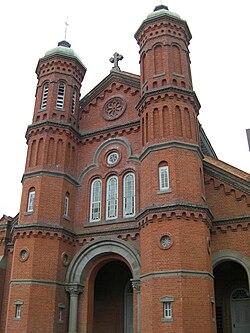world.wikisort.org - Japan
Tachiarai (大刀洗町, Tachiarai-machi) is a town located in Mii District, Fukuoka Prefecture, Japan.
Tachiarai
大刀洗町 | |
|---|---|
Town | |
 Imamura Catholic Church | |
 Flag | |
 Location of Tachiarai in Fukuoka Prefecture | |
 Tachiarai Location in Japan | |
| Coordinates: 33°22′N 130°37′E | |
| Country | Japan |
| Region | Kyushu |
| Prefecture | Fukuoka Prefecture |
| District | Mii |
| Area | |
| • Total | 22.83 km2 (8.81 sq mi) |
| Population (April 30, 2017) | |
| • Total | 15,567 |
| • Density | 680/km2 (1,800/sq mi) |
| Time zone | UTC+09:00 (JST) |
| City hall address | 819 Tomita, Tachiarai-machi, Mii-gun, Fukuoka-ken 830-1298 |
| Website | www |
| Symbols | |
| Bird | Skylark |
| Flower | Cherry blossom |
| Tree | Ilex integra |
As of April 30, 2017, it has an estimated population of 15,567 and a density of 680 persons per km².[1] The total area is 22.83 km².
Tachiarai is divided into three neighborhoods: Ozeki, Hongō and Kikuchi. Much of the land is used for growing rice and other crops.
History
Tachiarai was home to an Imperial Japanese Army Air Force Base, established in 1919 and the Tachiarai Army Flight School, established in 1940, before American bombers destroyed them in 1945.
Tachiarai houses a Defense Intelligence Headquarters signals intelligence facility, which is used to monitor communications from transiting satellites, as part of a program codenamed MALLARD.[2]
Kakure Kirishitan community
Tachiarai was home to a community of Japanese hidden Christians (Kakure Kirishitans) who were present in the area since the 16th century, centered in the village of Imamura. They were one of the very few Kakure Kirishitan communities in Kyushu outside present-day Nagasaki prefecture. The community was quite successful in remaining hidden, avoiding being targeted by any crackdowns during the Edo period (1603-1867), when Christianity was either partially or completely banned. As other Kakure Kirishitan communities, the so-called "Imamura Christians" had unique practices and beliefs, such as the cult of a saint-like figure called "Joan Mataemon" whose historicity remains unascertained.[3][4]
In 1867, the community was "discovered" by Christians from Urakami, triggering a process of conversion to Roman Catholicism. This attracted attention from the local authorities as Christianity was still banned in Japan, resulting in a large number of arrests, although all Christians were released by 1868.[4] By 1912, there were 2,712 Catholics in Tachiarai, but those began to emigrate en-masse to Brazil and later to other South American countries.[5][6] In contrast to its centuries of hiding in Japan, Tachiarai's Catholic diaspora was highly active in Brazil, having participated in the foundation of the Colégio São Francisco Xavier in São Paulo, which for decades was the most renowned educational institution for Brazilian nikkeis,[5] and of churches in the cities of Registro and Promissão.[7][8]
The present-day Brick Gothic Imamura Church was constructed with materials donated from Germany and inaugurated in 1913.[5] In 2006, it was declared as a Tangible Cultural Heritage of Fukuoka prefecture, and in 2015, an Important Cultural Property of Japan.[9][10]
Attractions

Education
The Tachiarai Board of Education is located near Ozeki train station, and is titled "Dream Center".
There is one junior high school and four elementary schools in Tachiarai. There are also a number of nursery schools, and one private English school.
References
- "Official website of Tachiarai Town" (in Japanese). Japan: Tachiarai Town. Retrieved 21 May 2017.
- Gallagher, Ryan (May 19, 2018). "The Untold Story of Japan's Secret Spy Agency". Archived from the original on May 21, 2018.
- 伊藤慎二, 考古学からみた筑後今村キリシタン, 西南学院大学国際文化論集 29(2), 71-97, 2015-03
- 中川憲次, カトリック愛苦会修道会の歴史的研究(1)草創期, Fukuoka Jogakuin University bulletin Human relations (9), 47-53, 2008-03
- 佐藤早苗, 奇跡の村 : 隠れキリシタンの里, 河出書房新社, 2002
- 林雅孝, 社会体制と家族の変化, 日本社会分析学会、機関誌No.10-11
- Shiguti, Aldo (22 January 2008). "Missa na Igreja Cristo Rei dos 26 Mártires deve atrair 2 mil romeiros" (PDF). Jornal Nippak - Ano 11 - N. 2191. Retrieved 27 January 2021.
- Nikkey Shimbun, 日本移植民の原点探る=レジストロ地方入植百周年 ◇戦前編◇ (72)=最古の日系カトリック教会=不思議な政治的設立経緯, 13 Nov 2013, visited on 19 July 2021
- "福岡県国・県指定文化財:有形文化財" (PDF). 福岡県. Retrieved 18 April 2017.
- "今村天主堂". 国指定文化財等データベース. 文化庁. Retrieved 18 April 2017.
External links
 Media related to Tachiarai, Fukuoka at Wikimedia Commons
Media related to Tachiarai, Fukuoka at Wikimedia Commons- Tachiarai official website (in Japanese)
На других языках
[de] Tachiarai (Fukuoka)
Tachiarai (jap. .mw-parser-output .Hani{font-size:110%}大刀洗町, -machi) ist eine Stadt im Mii-gun in der japanischen Präfektur Fukuoka.- [en] Tachiarai, Fukuoka
[ru] Татиараи
Татиараи (яп. 大刀洗町 Татиараи-мати) — посёлок в Японии, находящийся в уезде Мии префектуры Фукуока. Площадь посёлка составляет 22,83 км²[1], население — 15 161 человек (1 августа 2014)[2], плотность населения — 664,08 чел./км².Другой контент может иметь иную лицензию. Перед использованием материалов сайта WikiSort.org внимательно изучите правила лицензирования конкретных элементов наполнения сайта.
WikiSort.org - проект по пересортировке и дополнению контента Википедии